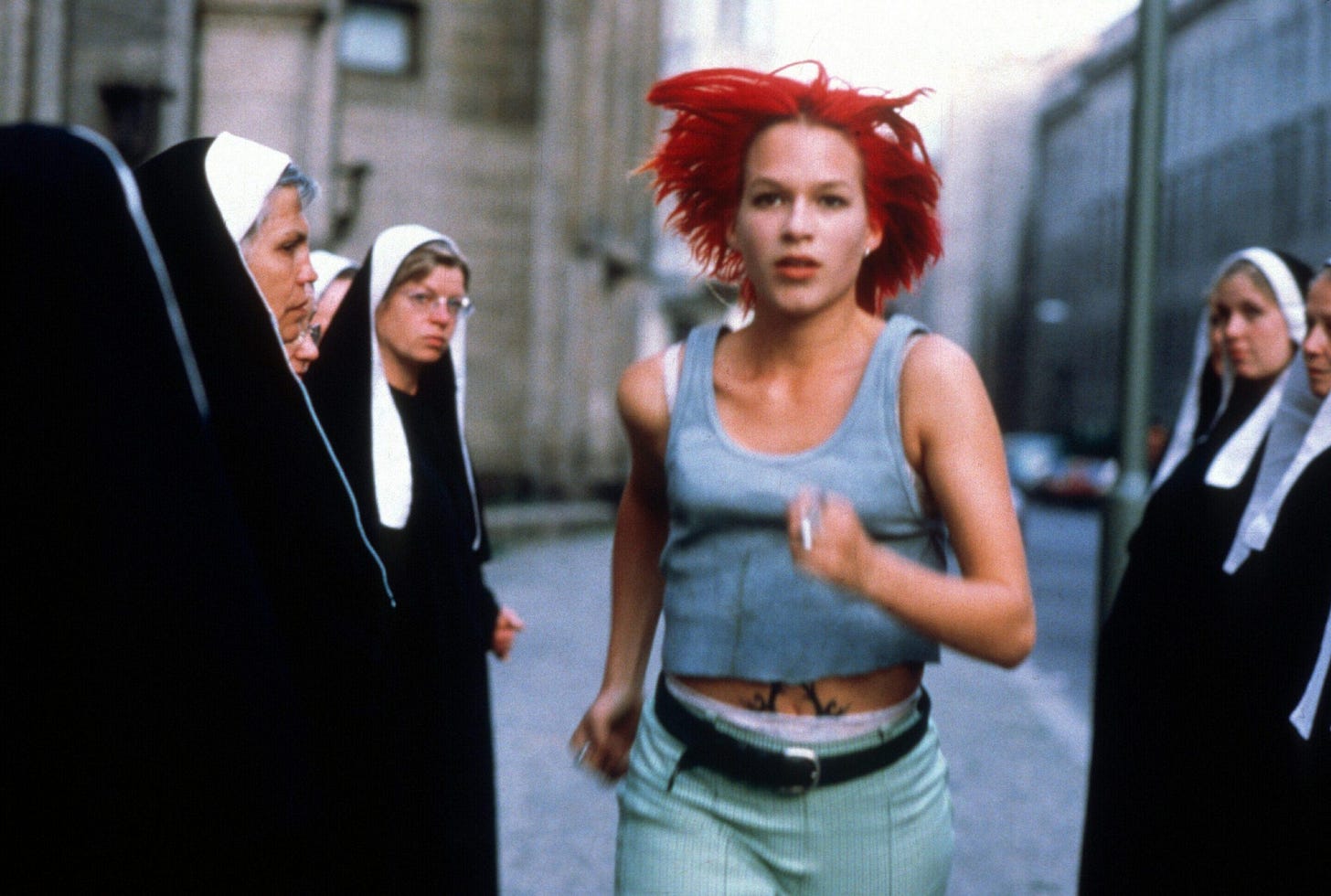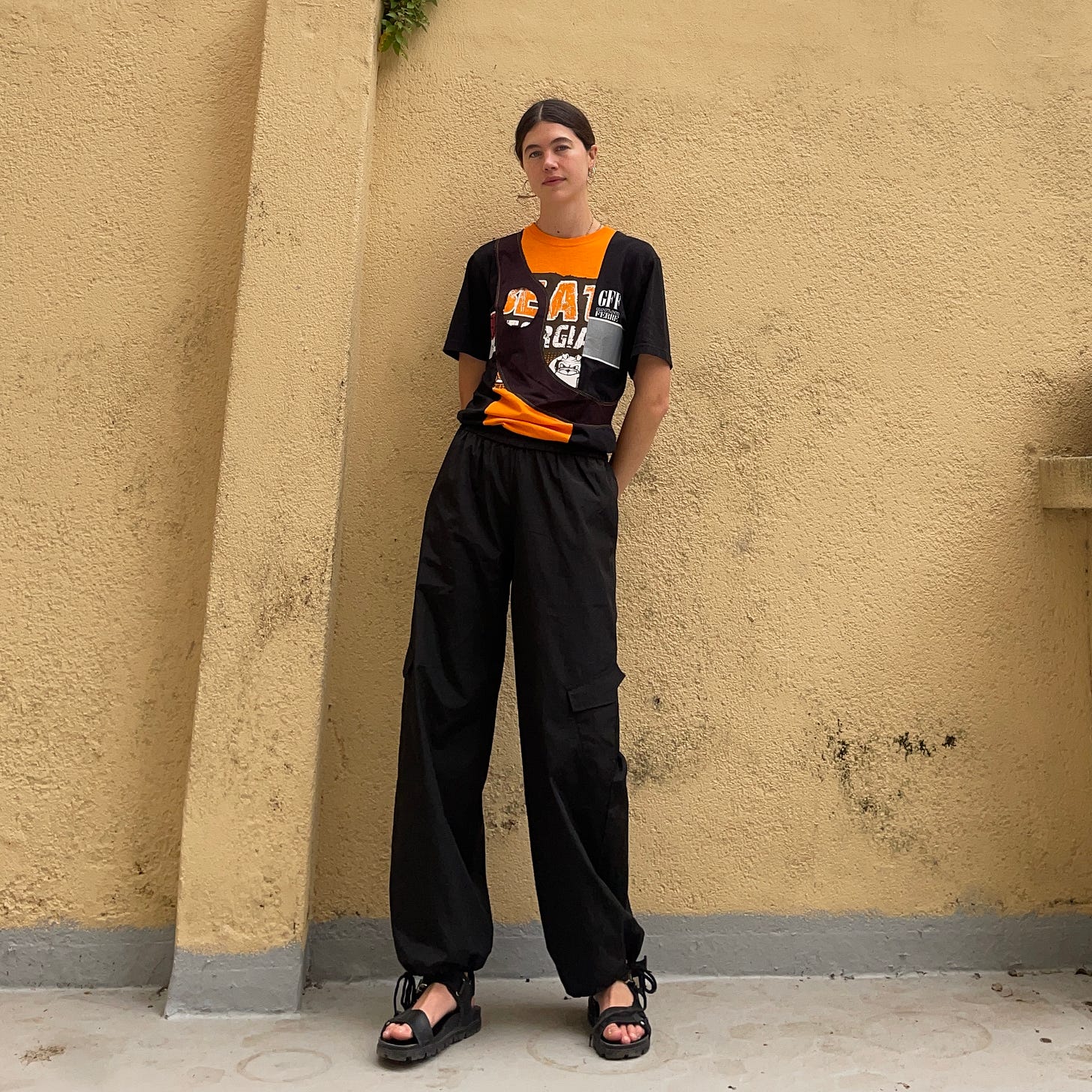When I was 11 years old, my mum took me with her to the hairdresser. She’s a pretty low maintenance lady, but like many women, hair has always been her chosen indulgence. Back then, she used to visit an upmarket place in West London for her routine cut and colour. To tweenage me, it all seemed impossibly glamorous, the scent of luxurious mousses, creams and gels floating through the salon on a cloud of warm hairdryer air.
As the stylist applied the foils to mum’s head, she turned to me and asked if I’d like to get one too. A single foil, any colour, she offered. As a young fashion obsessive desperately searching for my personal style, I jumped at the chance, choosing a deep cherry red from her collection of shades.
An hour or so later, we left the salon, transformed. Mum had gone from wispy grey to a neat, honeyed bob, whilst I twirled my new red streak proudly between my fingers. At school, my friends were impressed. I felt braver, more rebellious. My ruby lock was a signifier of subversive sophistication - the portal to a unique brand of cool that was part-moody, part-mysterious.
My next encounter with red hair came later in my teens, during a German class. My teacher was a fiercely intellectual queer woman, whose impeccable style vastly outshone the rest of the drab teaching staff. At the end of term, she showed us the film ‘Run Lola Run’, a 1998 thriller about flame-haired Lola (Franka Potente), who has 20 minutes to find 100,000 marks to save her boyfriend’s life.
As the title suggests, most of the film features Lola sprinting through the streets of Berlin. Somewhere between a supermodel and a superhero, she wears the ultimate 90s uniform of dishevelled tank, exposed bra, loosely tailored pants and Doc Martens. Potente epitomised this nonchalant nineties cool, saying in an interview: “I didn’t train – I probably smoked two packs a day back then – but I was young. And we wanted Lola to look like a real person, not an athlete.” The film was a runaway hit (pun intended) in both Germany and the States, and Lola’s crimson hair launched thousands of copycats.
This wasn’t the first time a German film had inspired viewers to dye their hair red. 17 years earlier, the 1981 film ‘Christiane F’ made waves for its stark depiction of teenage drug use, following the story of a 14-year-old addict who descends into the seedy Berlin underworld after trying heroin at a David Bowie concert. Bowie himself features in the film, and his music is the soundtrack.
The movie quickly became a cult hit, and has been referenced time and time again, most notably by Raf Simons, who featured images of the film’s redheaded protagonist in his Fall 2001 ‘Riot Riot Riot’ collection, his 2003 book ‘The Fourth Sex’ and again in his Fall 2018 show. Despite its harrowing themes, Christiane’s look was widely imitated - her stringy red hair a symbol of wayward youth and teenage angst.
Flash forward to the present day, and I’m noticing the red-hair trend creeping into fashion again. There was Solange’s recent cover of Harper's Bazaar US, shot by Larissa Hofmann and styled by Carlos Nazario. She wears her leather Prada two-piece as casually as if it were a thrift store find she decided to throw on. Her hair - coiffed by the legendary Jawara - is a cinnamon halo, a force field of energetic cool.
Then Phoebe Philo’s latest announcement dropped into my inbox. Characteristically minimal, the subject line simply read “Second edit is available”, with a photo of one of her enigmatic models in the email body. The model in question wears Philo’s column skirt and a crisp shirt, but it’s her hair that completes the look. The shade is somewhere between the berry of the skirt and the bright red of the brand’s logo.
I messaged my friend Jadah Dale (owner of Studio Studios, and the secret weapon behind London’s best hair) to get her thoughts on my hypothesis. “I’ve been noticing more of a classic 2000s red look coming back, more plummy, browny tones,” she told me. “It’s been on the rise for the past 3 or so years, starting with more peach tones to more orangey soft strawberry gingers, and then those browny gingers that people were into.”
So what is it about red hair that makes it such a ‘cool girl’ colour? “Even though it does take a lot of work to get the perfect red, I don’t think you’d know that from looking at it. So I think it’s dark effortlessness that’s making it cool,” Jadah said. “People want a more moody, lived-in look.”
Still, when only 2% of the world are natural redheads, red hair implies both rarity and decisiveness. Where dye is concerned, it takes a strong character to make such a bold and unusual choice.
Browns Fashion’s Head of Buying Heather Gramston is one of Jadah’s regulars. For her, she liked the fact that red hair speaks volumes against her otherwise sleek aesthetic. “Having red hair is a conversation starter, whether you want to engage or not,” she said. “It makes a statement with minimal effort which appealed to me, plus I enjoyed the contrast against my black-only wardrobe.”
As for inspiration, “I had colour references at each stage of going from ginger to red - Lourdes Leon and model Louise Robert, who was a prominent fixture on the runway in ‘22/23 and was my inspiration to go flame red.” There’s also the nostalgia factor. “It feels a bit like it’s going back into the 90s and 2000s, the Rihanna red era,” noted Jadah. “So I wonder if that influences its coolness, just being in the nostalgic cultural Zeitgeist.”
One person who got a lot of messages when Solange’s Harper's Bazaar shoot came out was stylist Shibon Kennedy, whose hair bears a striking resemblance to the cover. “I’m not even kidding, like 15 different people said that I was the moodboard!” She laughed. She started dyeing her hair a couple of years ago, after playing around with an Instagram filter and realising she loved the look. “Red matches my fiery spirit. I feel like I was born a redhead, I just didn’t have the gene,” she told me. “I’ve never felt so connected to my hair as when I dyed it red.”
She remembers the moment it clicked. “I was walking in a sea of New Yorkers during rush hour. My hair was big and red and curly, and I was the only redhead. I stood out and I loved it. I was like, ‘This is my vibe. This is me taking up space in a way that I really enjoy.’” Her initial inspo came from The Little Mermaid - “Mother-fuckin Ariel, but the Black version! The first round I was a little bit more auburn, and then I went punchier, brighter - after I did that people were like ‘Oh, Kelis, ‘Kaleidoscope’ which is a cool reference, but I didn’t even think of that one.”
Perhaps the appeal of red also has something to do with our culture of overexposure. When someone dyes their hair red, they know they’re going to attract attention. And yet, the hair does the talking. I think of all the women I admire who have red hair, and there’s a certain unknowability about them. The red hair is the tip of the iceberg - it implies there’s passion within, without spelling out exactly what that is or how it manifests.
Other women on my red hair radar include pop star Dua Lipa, fashion critic Rian Phin and Climax Books founder and Acne Studios CMO Isabella Burley - women who champion strong points of view and an independent attitude. The red hair signals that they’re in control. It also hints that maybe, every once in a while, they might get out of control, too. “I think it’s a lot of fun,” said Burley, mischievously.
At this point, I can’t help but return to Phoebe. Although she’s not a redhead herself, she’s made the colour a strong part of her aesthetic. I’m thinking about the interview she did with Vanessa Friedman (also a redhead) for the New York Times, in which Philo carefully dodged questions around the stories behind her clothes.
“I don’t feel that there’s a huge amount of storytelling that needs to be done,” Ms. Philo, 50, said. The subject was Ms. Philo’s reluctance to talk: about her work, her plans, her self.
“I’m not particularly into that,” she went on. “I don’t feel myself that I need a lot of that from other fashion houses. I feel that it’s just not necessary. To a certain extent you either like it or you don’t. Someone telling me a story isn’t going to make me like it more. It is a coat. It’s a pair of trousers. I do appreciate a level of straightforwardness.”
The comments went wild. No storytelling! So expensive! Who does she think she is? Some praised her refusal to explain, whilst others felt exasperated by her mystery. That same brand of mystery worn by her red-haired model, who casually announced the second edit in my inbox. Here, red hair represents the cool, detached attitude that characterises both the designer and her clothes.
When someone withholds themselves in this way, it’s frustrating and intoxicating in equal measure. In the end, it usually makes them more desirable. And the colour of desire is red. It can be elegant or angry, sumptuous or seedy. It’s a daring and decisive choice, neither the brassy ‘look at me’ energy of blonde, nor the indifference of brunette. A woman who dyes her hair red is choosing herself. Even today, that’s a radical choice.
Don’t forget to subscribe for more Threads of Conversation. You can also listen to the podcast on Apple Podcasts or Spotify, and follow on Instagram.
Threads of the week
Got these amazing technical cargo pants from a Portuguese vintage brand called Daia. Worn with Prada sandals and upcycled Lueder t-shirt. Not sure why the camera angle makes my legs look so long! I’ll take it, though.
Loose Threads
Institute of Digital Fashion just published their first Futures column for Office magazine.
A musician I really liked, Cola Boyy, passed away this week. He was a special guy, and an incredible advocate for disabled people and artists. Have a listen to some of his tunes.
Start your own Thread
Add your thoughts in the comments, and let me know whose Threads of Conversation you want to hear next! And if you enjoyed this edition, why not forward it to a friend?

















Loved this!